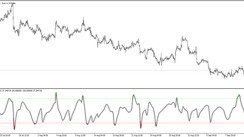Trading and investing involve complex decision-making, one of which includes figuring out the ideal time to part with a stock. This can be especially daunting when your assets are appreciating. The dilemma often lies between prematurely selling a potential high performer and holding onto an underperforming stock, anticipating an upturn. So, how does one make an informed decision on when to offload their stocks?
If you're just dipping your toes into the trading waters, it's reassuring to know there are numerous indicators to guide whether a stock is ripe for selling. In this article, we'll delve into these indicators and explore some tools to facilitate your sell-or-hold decisions.
Market Behavior: Safeguarding Profits
Generally, when traders sense an impending depreciation in an asset's value, the preference usually leans toward capitalizing on existing profits to evade potential losses. While this approach might seem counter-intuitive, it is consistent with typical trader behavior and human nature, influencing numerous tough market decisions. Although this tactic may safeguard your portfolio value to a certain degree, patience often pays in the long run since stock markets are likely to recover, continuing a stock's successful streak.
Different schools of thought exist, where some advise never to sell winning stocks despite occasional dips, while others advocate cautious selling. The latter group usually operates with a stringent method and adheres to their process before selling a prosperous stock.
Utilizing Financial Ratios
If your stock has been on a winning spree, it's natural to feel elated, but complacency can be costly. It's crucial to stay vigilant for signs that it might be on the brink of a downward spiral. These indicators often manifest through financial ratios.
A company's health that issues the stock can be evaluated through a fundamental analysis, comprising a detailed scrutiny of financial statements. Veteran traders, analysts, and professionals use financial ratios for insights and attempt to predict the company's future performance. However, the data required to calculate these ratios might not be easily accessible, as most companies guard their financial information meticulously.
Essential Ratios to Consider
If you can access financial statements, several figures can provide a deeper understanding of a stock's value, such as the dividend yield, price-to-earnings (P/E) ratio, earnings per share (EPS), and dividend payout ratios. Further key ratios to enrich your knowledge include debt to equity, quick ratio, current ratio, and other liquidity and solvency measures.
Employing Target Prices
Several traders establish a minimum stock price, selling if it falls beneath this threshold to preserve profits. Conversely, an upper limit can also be set, triggering a sale.
The apprehension of the market not sustaining a price above a certain point and a whiff of adverse news potentially plummeting the price may lead to such a strategy. Predetermining selling and buying limits can help alleviate such fears.
Monitoring Dividends
A decrease in dividends or a complete cut warrants a thorough investigation into a company's internal operations. Investors should regularly monitor the monthly and quarterly performance of the companies issuing their stocks. A decrease in dividends may indicate significant changes, cash flow issues, or other challenges that could impact stock value.
It's worth noting that not all companies are obligated to pay dividends. Cuts or reductions in dividends don't always signify financial distress; a company might reinvest the funds into retained earnings or channel the money towards research and development.
Monitoring Trading Volume
A sudden drop in trading volume might hint at impending trouble. Stock liquidity, the ease of buying or selling a stock, is crucial for traders wishing to offload underperforming stocks. If buyers are scarce, you might be forced to retain the stock, weathering its decline, and hope the company navigates through the rough patch.
Strategies to Consider When Selling
Adopting a broader perspective can be advantageous when contemplating selling your stocks. If you're cognizant of market contexts and external factors impacting stock value, you'll have a well-rounded view guiding your actions.
Impact of Media Hype
If your stock suddenly garners media attention, it might be an opportune time to take profits. Media-induced stock frenzies can attract all types of market players, often leading to rapid buying and consequently inflated stock prices. However, when the hype wanes, stock prices can plummet, leaving you with a negative return on investment.
Evaluating Growth Stocks
Growth stocks are expected to show continual growth. If they stagnate or the growth slows, it may be time to consider selling. The market is often unforgiving towards growth stocks that fail to uphold their growth momentum.
Diversifying Your Holdings
If you've amassed a substantial profit on a stock, consider selling a portion of your shares. The profits can be reinvested into other well-performing stocks, while the rest can stay put. This approach distributes the risk across a variety of assets while ensuring profits. If the remaining stocks start to underperform, you can sell them and hopefully, walk away with some profit.
Caution Against Excessive Trading
While maximizing investment gains is the primary objective, it's vital to be mindful of the costs associated with each sale. Excessive trading can lead to hefty broker's fees, eating into your profits. A few wise trades are generally more profitable than a flurry of mediocre ones.
Frequently Asked Questions
Is it wise to sell stocks at a loss?
Selling stocks at a loss is usually ill-advised unless it's part of a pre-determined trading strategy. In this case, your stop-loss order may lead to selling stocks at a loss, but that's a risk you accepted when entering the trade. The best approach is to have a plan for each trade and adhere to it unless there are significant changes in the underlying business.
When is it ideal to sell bonds?
Traders typically sell bonds when they anticipate a rise in interest rates. Higher interest rates drive bond prices down, so capital gains are maximized when interest rates are lowest. However, fluctuations in bond prices don't affect interest payments for investors who hold bonds till maturity. If your current income level is satisfactory and the bond issuer's creditworthiness remains unchanged, there's no rush to sell.





